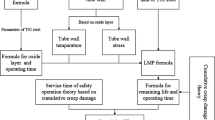The creep damageability and long-term strength of a tubular solid oxide fuel cell are studied. The method for the solution of the initial boundary value problem of creep and damageability is based on the joint application of the R-function and the Runge-Kutta–Merson methods. An example of the calculation of the creep and long-term strength of a Siemens-Westinghouse fuel cell is given.



Similar content being viewed by others
References
A. Bieberle-Hütter, D. Beckel, A. Infortuna, et al., “A micro-solid oxide fuel cell system as battery replacement,” J. Power Sources, 177, 123–130 (2008).
N. Hotz, S. M. Senn, and D. Poulikakos, “Exergy analysis of a solid oxide fuel cell micropowerplant,” J. Power Sources, 158, 333–347 (2006).
J. H. Joo and G. M. Choi, “Micro-solid oxide fuel cell using thick-film ceria,” Solid State Ionics, 180, 839–842 (2009).
J. F. Vente, S. McIntosh, W. G. Haije, and H. J. M. Bouwmeester, “Properties and performance of BaxSr1-x Co0.8Fe0.2O3-δ materials for oxygen transport membranes,” J. Solid State Electrochem., 10, 581–588 (2006).
K. Fisher and J. R. Seume, “Impact of the temperature profile on thermal stress in a tubular solid oxide fuel cell,” J. Fuel Cell Sci. Technol., 6, 011017-1–011017-9 (2009).
J. Crank, The Mathematics of Diffusion, Second Edition, Oxford University Press (1975).
A. A. Zolochevskii, A. N. Sklepus, and S. N. Sklepus, Nonlinear Mechanics of Deformable Solids [in Russian], Biznes Investor Grupp, Kharkov (2011).
V. I. Krylov, V. V. Bobkov, and P. I. Monastyrnyi, Computing Methods [in Russian], Nauka, Moscow (1977).
V. L. Rvachev, Theory of R-Functions and Some of Its Applications [in Russian], Naukova Dumka, Kiev (1982).
A. Nakajo, C. Stiller, G. Härkegård, and O. Bolland, “Modeling of thermal stresses and probability of survival of tubular SOFC,” J. Power Sources, 158, 287–294 (2006).
F. L. Lowrie and R. D. Rawlings, “Room and high temperature failure mechanisms in solid oxide fuel cell electrolytes,” J. Eur. Ceram. Soc., 20, 751–760 (2000).
E. Lara-Curzio, “Durability and reliability of SOFC materials and components,” in: Proc. of 7th Annual SECA Workshop and Peer Review (Sept. 12–14, 2006, Philadelphia).
Author information
Authors and Affiliations
Corresponding author
Additional information
Translated from Problemy Prochnosti, No. 1, pp. 63 – 71, January – February, 2014.
Rights and permissions
About this article
Cite this article
Sklepus, S.N., Zolochevskii, A.A. A Study of the Creep Damageability of Tubular Solid Oxide Fuel Cell. Strength Mater 46, 49–56 (2014). https://doi.org/10.1007/s11223-014-9514-1
Received:
Published:
Issue Date:
DOI: https://doi.org/10.1007/s11223-014-9514-1




